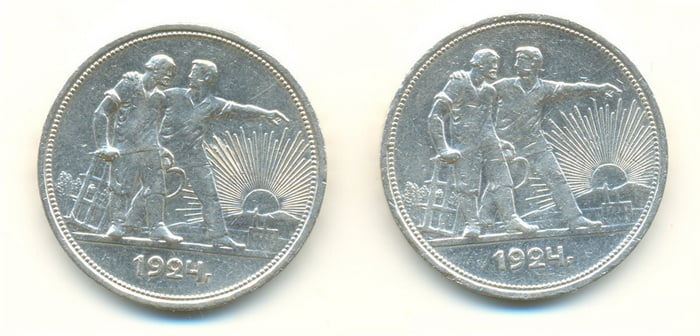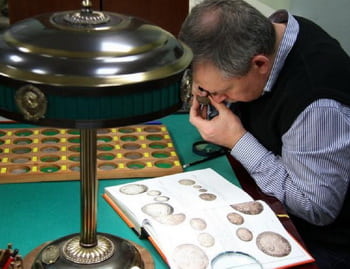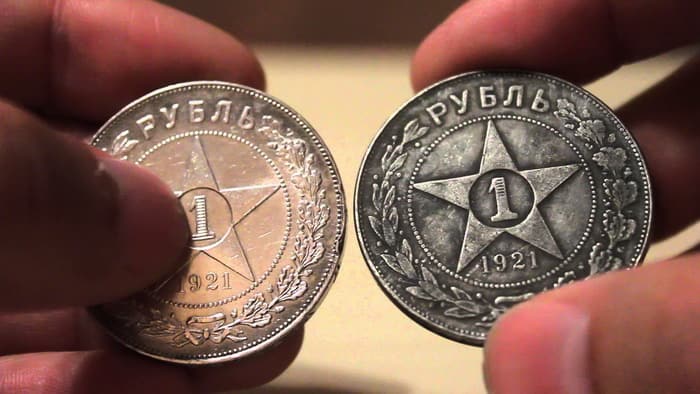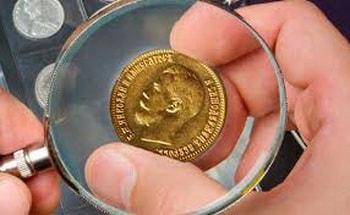
The first coins appeared about 3,200 years BC. So did the first counterfeit coins. The counterfeiters were looking for ways to get some lucre by skillfully copying money from precious metals (gold and silver) using cheaper material. However, even at that time, people knew how to verify the authenticity of a coin. Today, the interest in bullion and collectible series has increased again, which provoked a new growth of counterfeits. It has become much more challenging to distinguish modern copies from the original, as they are minted on high-tech equipment with all the specialized knowledge about the production process.
Methods of counterfeiting coins
In the 20th century counterfeiting of silver coins was very popular. There was a hole (sometimes several) made on the surface, the removed piece of silver was sent for melting, and the cavity was filled with lead or tin. It was impossible to determine the authenticity of such an item. It was impossible to do this with gold coins, so another method was invented. The counterfeiters etched the image from the surface or cut the coin in half along the edge, and then filled it with the base metal. In both cases, the difference between the counterfeit and the original was only in weight.
Do you know? During the war, the opposing countries produced counterfeit coins of the country with which they fought. This method was invented to bring down the enemy’s economy. One of the most known cases is connected with the British government, which flooded America with counterfeit currency during the War of Independence in 1776. The British did it again during World War II. The most obvious reason was the possibility of creating hyperinflation.
The attempts to mint counterfeit coins in the 19th – 20th centuries did not lead to intended effect. It is impossible to repeat the image and reeded edge on cheap equipment. The image and letters turned out to be blurry. Other methods, such as casting or fabricating counterfeit coins manually, were not profitable – it took a lot of time and effort, and the result was unsatisfactory. Later the professional equipment appeared which could produce a counterfeit of improved quality in large quantities. They diluted the alloy or replace it with a cheaper analog to do this.

The modern counterfeits are bullion and collectible coins. They are difficult to distinguish from the original, but if there is specialized equipment, you can identify the main parameters, even if the numismatist is not a professional. These parameters are:
- weight;
- quality of the edge;
- the presence of the rim;
- the sound of falling.

A particular form (a cliché for the obverse and the reverse of the coin) is used for minting counterfeits. A cheap alloy is poured into the cavity, and then it is extracted and painted in the right color. The relief is clear, and there are no bubbles on the surface. Weighing will help to distinguish a counterfeit from the original. For rare items, a die-imitator is used (the method is too time-consuming and expensive)
Do you know?
A round coin of 1 pound denomination, issued in 1983, was one of the oldest British coins in circulation. Over time, it was increasingly counterfeited, which led to significant costs for industry, the general public, taxpayers and society as a whole. As a consequence, the new 12-side coin of £ 1 was put into circulation on March 28, 2017.
The counterfeiters learned to counterfeit patina (a beautiful touch on old coins, which appeared due to oxidation and always served as a guarantee of the original). Artificial aging concerns Chinese counterfeiting of coins. It is done in several ways – baking in the oven, burning with a blow lamp, bleaching, fumigating and applying acid. The surface is less shiny, but the coin remains a counterfeit.
Authentication Tools
The obvious counterfeit can be distinguished by putting the original and the counterfeit side by side. If such a method gave no results or there still doubts, there is a set of tools that can help you distinguish a counterfeit coin from the original:

- Detailed catalog world’s gold and silver coins. Specialized magazines contain a full description of collectible and bullion coins. The information includes weight, diameter, type of minting and edge, images on the obverse and reverse, physical and chemical properties (alloy, composition).
- Electronic scale. Each coin has the exact weight to the nearest hundredths, so any deviation from these numbers will mean that the sample is a counterfeit.
- Magnifying glass. With the help of this device, you can carefully study the small details and compare them with the original coins or catalog. The hardest thing to counterfeit is Proof coins. Since the glossy surface and letters are at an angle of 90 degrees to the surface, they are not so easy to copy.
- Spectrometer. The device shows the most accurate result of whether the item is an original or counterfeit. With its help, you can determine the amount of admixtures in the metal.
Do you know? Nowadays, depending on the gravity of a crime, counterfeiters will most likely be fined. However, in the 18th century, there had been another story. Benjamin Franklin himself printed warnings about counterfeiting of 20 shillings, which indicated “counterfeit is death.” People, who were caught on counterfeiting money in England in the 18th century, were hanged or quartered.
It is often difficult to understand how to distinguish a counterfeit if they are royal coins. The actual weight, as well as the condition of the edge and letters, varied from item to item and often departed from the norm. On copies of the 18th century, these parameters were unequal, even for circulation of the same year. It is known that the coins of Catherine II, Paul and Alexander I differ by 2-2.5 grams, so you need to watch the ornament of the cord-like edge.

How to identify the authenticity of a coin?
High-tech equipment and manual labor are used on the manufacturer, where coins are minted. It provides a quality design of the surface, taking into account all technical and geometric features. In “handicraft” conditions, it is rather difficult to repeat this. Therefore, the more difficult the manufacturing of a coin is the easier it is to identify any deviations from the standard.

Do you know? In some trade publications, it is noted that thousands of copies of popular coins, such as the American Silver Eagle, the Canadian Gold Maple Leaf and American Buffalo (the most expensive and profitable bullion coins from the gold of the highest fineness) are made in factories in China. The cost of such copies on the Chinese markets is from $ 1 to $ 3 .
There are several easy ways to check a silver or gold coin for authenticity:
- worth paying attention to chipped spots and worn spots while checking. These things also give a loss in weight.
- Dimensions. It is necessary to take a closer look, and then measure the diameter and thickness of the coin using a caliper. Errors in such cases are permissible only for the royal coins.
- Fineness of metal. A significant deviation from the standard fineness is noted only in the royal coins, so it will be difficult to distinguish a silver coin of 1718 from counterfeit.
- Obverse, reverse, edge. One of the easiest ways to check is to put a coin on its edge. If it falls, then it is an obvious counterfeit. You should also inspect the edge for the presence of grooves and seams. The presence of one of these things indicates a counterfeit. On the reverse and the obverse of such coins, little details are missing or poorly done, and there are also bubbles visible even without a lens.
- Color and shine. If the shine is too saturated, there is much zinc in the coin. Matte gloss suggests that the item is simply gilded.
Do you know? Sometimes counterfeit of collectible coins is a really profitable business. The rare coin of 1920 (half a Liberty dollar) was copied by counterfeiters and sold for 40,000 dollars.
Replica, mint-made errors (sometimes they are even more valuable among numismatists than the original) or new-made coins (the official copy of the mint) are not counterfeits.

Comments
No commens yet.